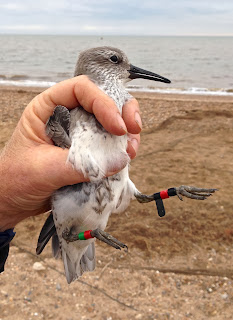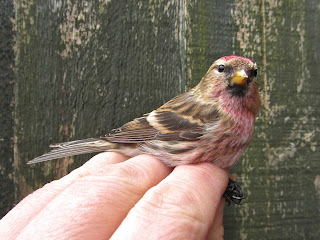Banding ...
It's strange how two English speaking countries can have a different word for the same activity and as a British ringer it can take quite a long time to get used to talking about banding and the different codes used to record the species, age and sex of birds in the hand. Last week found me back in Ontario with my Canadian friends banding birds at Prince Edward Point Bird Observatory (PEPtBO), which is a participating member of the Canadian Migration Monitoring Network. I was really lucky to spend two and a half months as the long term fall assistant at this banding station in 2012 and was looking forward to going back and meeting the new team this autumn.
After a smooth and uneventful flight from Heathrow where I'd heard my first Redwings of the autumn zitting over as I parked up in long stay it was odd to find myself walking out of Pearson International Airport at Toronto into a bright and sunny Canadian afternoon 10C warmer than that being experienced by the UK I'd left behind. Pamela Stagg, one of the volunteers at PEPtBO, a Canadian birder and my kind host for the week was waiting to drive me the two hours north east back to Prince Edward County.
The PEPtBO banding lab taken last fall
My stay was to be split between spending time at the bird observatory helping with the fall banding effort and birding some local hotspots although my first lifer for the trip was seen flying over a county road on the way back from the airport; three Sandhill Cranes were a nice start although augmented only by an elusive American Coot later on in the week near Presqu'ile Provincial Park.
Eastern White-crowned Sparrow (left), Blue-headed Vireo (centre)
and Brown Creeper (right)
A male Golden-crowned Kinglet!
As it happened the days I chose to visit PEPtBO were the most productive during the week of my stay with high winds and the odd rain shower forcing nets to remain unopened on a few occasions. The bulk of the birds moving through at this time of October are Golden-crowned Kinglets, Ruby-crowned Kinglets and Brown Creepers but these were joined by some straggling Hermit Thrushes, some late Blackpoll and Black-throated Blue Warblers and surprisingly a Black-throated Green warbler. Interestingly the Brown Creeper is migratory unlike it's distinctly sedentary Treecreeper counterpart in Britain.
Female Black-throated Blue Warbler (left), HY Myrtle Warbler (centre)
and HY Blackpoll Warbler (right)
Dark-eyed Juncos and White-throated Sparrows were just starting to arrive in numbers, joining the greedy Eastern White-crowned Sparrows that take advantage of the cracked corn used as bait for the various walk-in ground traps. Later on in the week four Eastern Phoebes were also caught, typically the last of the flycatchers to come through.
HY Eastern Phoebe (left), Black-capped Chickadee (centre)
and HY White-throated Sparrow (right)
Before making the trip I'd been keeping an eye on the reports from a number of the Ontario hawk watches and given that migration had slowed down dramatically it wasn't surprising to catch just a single Sharp-shinned Hawk, with very few moving over. This changed for my last morning at the obs on Friday with favourable winds funnelling a large kettle of Turkey Vultures down to the point. These were accompanied by a few treats such as a Red-shouldered Hawk, a juvenile Golden Eagle and a stunning adult Bald Eagle; a handful of Red-tailed Hawks were also moving through.
The quintessentially north american Blue Jay
... and birding
The week wasn't just about banding however and I was starting to build quite a few eBird lists including a few from Pamela's backyard adding species such as Cedar Waxwing and Merlin along with Pileated Woodpecker which eluded me in Canada last year. Great trips were made to Frontenac and Presqu'ile Provincial Parks each amazing in different ways.
Frontenac is on the southern perimeter of the Precambrian Canadian shield which extends as far north as Nunavut, the Northwest Territories and the edge of Greenland. The scenery is shaped by igneous rocks over 570 million years old and the landscape is quite distinct even when viewed from an airliner at 38000 feet. Frontenac shares much of it's beautiful habitats with the more well known Algonquin Park and both are characterised by extensive mixed forest surrounding wide lakes and extensive wetlands that are home to a wealth of wildlife and the woodland looks simply stunning in the reds, oranges, yellows, and browns that make up the familiar fall colours of the northern Untied States and Canada in the fall.
One of the many lakes at Frontenac
Downy Woodpecker amongst fall foliage (left)
and it was still warm enough for a Garter Snake (right)
Chipmunks were still active in the unseasonably mild fall
Presqu'ile, bordering Prince Edward County to the west is a small provincial park that juts out into Lake Ontario. Part of the park was once an island but as sand was deposited by glacial meltwater a feature known as a tombolo now forms a wide, stable and vegetated connection to the mainland. Presqu'ile is the best place to see shorebirds (waders in English!), near Prince Edward County and a flock numbering upwards of a hundred eventually yielded a couple of late White-rumped and Baird's Sandpipers amongst the Dunlins and Sanderling; a few Pectoral Sandpipers were also present and easily spotted amongst the other Calidrid species. Walking back along a woodland trail accompanied by a few Sulphur butterflies, several dragonfly species and Fringed Gentians flowering amongst the autumnal Poison Ivy foliage, it was clear the fall was an uncommonly mild this year - enjoyed by people and wildlife in equal measure.
The lakeshore at Owen Point, Presqu'ile
Pectoral Sandpiper above Dunlin at Owen Point (left)
and Fringed Gentian one of the few plants in flower (right)
Presqu'ile is also home to the largest protected wetland on the northern shore of Lake Ontario and is a fantastic spot to see wildfowl, herons and raptors such as Northern Harriers and Merlin. Given the timing of my visit I was to early to witness the large rafts of sea ducks that build up in the lake offshore and too late for the main warbler migration but I was happy enough to find a Sedge Wren from the marsh boardwalk and watch Black-capped Chickadees helping themselves to insects from the Cat-tails.
View over the marshes at Presqu'ile
It was a short week but birding and banding was productive, the weather kind enough to wear sandals everyday, new friends were made an old friends laughed with, you know who you are!
I guess there's just one more thing to mention; how cute are Northern Saw-whet Owls? I've spent the last twelve months missing these birds! PEPtBO participates in Project Owlnet and operates a six week owl banding program in the latter half of each fall. The owls are frequently caught by other banders in the flyway and a good amount of data is being collected about their migration and ecology, helping to make positive conservation effort possible.
Northern Saw-whet Owl
currentVote
noRating
noWeight
















































